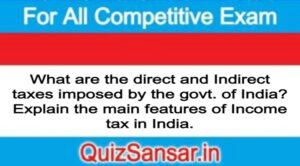
What are the direct and Indirect taxes imposed by the govt. of India? Explain the main features of Income tax in India.
What are the direct and Indirect taxes imposed by the govt. of India? Explain the main features of Income tax in India.
Or
Write short notes on the following: (a) Property tax, (b) Education Less (c) Gift tax.
Or
Evaluate the tax revenue of the central govt. of India.
Ans.
Taxation India
The Indian is quasi-federal in nature, and the country has three tier government structure.
To avoid any disputes between the centre and state the Constitution envisage following provisions regarding taxation-
1. Division of powers to levy taxes between centre and state is clearly defined.
2. There are certain taxes which are levied by the centre, but their proceeds are distributed between both centre and the state. Example Union Excise Duty.
3. There are certain taxes which are levied by the centre, but their proceeds are transferred to the states. Example-Estate duty on property other than agriculture income.
4. There are certain taxes which are levied by the central government, but the responsibility to collect them is vested with the states. Example- Stamp Duty other than included in the Union List.
5. There are certain taxes which are levied by the states, and their proceeds are also kept by states. Example-Erstwhile VAT.
What is a Tax?
Taxes are generally an involuntary fee levied on individuals and corporations by the government in order to finance government activities. Taxes are essentially of quid pro quo in nature. It means a favour or advantage granted in return for something.
Understanding Regressive Nature of Indirect Taxes
Government Levies a tax of 5 percent on a pack of 5KG Rice worth Re 1000.
Tax Burden on the Pack: 5/100 x 1000 – Re. 50
1. Rich Individual Case (Monthly Earning 1 Lakh)
He buys the rice pack and pays a tax of Re. 50
The proportion of his income that went on paying tax on Rice is 0.05 Percent (50/1000000) of his total earning.
2. Poor Individual Case (Monthly income Re. 1000)
He buys Rice pack and pays a tax of Re 50.
The proportion of his income that went on paying tax on rice is 5 percent (50/1000) of his total earning.
As you can clearly see, a poor individual is paying a higher proportion of his income as indirect tax as compared to the richer individual.
Taxes in India: In India, Taxes are levied on income and wealth. The most important direct tax from the point of view of revenue is personal income tax and corporation tax.
Income Tax : Income tax is levied on the income of individuals, Hindu undivided families, unregistered firms and other association of people.
In India, the nature of income tax is progressive.
For taxation purpose income from all sources is added and taxed as per the income tax slabs of the individual.
Surcharge of 10% of income tax where the total income exceeds Rs 50 lakh up to Rs 1 Crore.
Surcharge of 15% of income tax, where the total income exceeds Rs 1 Crore.
Corporation Tax: Corporation tax levied on the income of corporate firms and corporations.
For taxation purpose, a company is treated as a separate entity and thus must pay a separate tax different from personal income tax of its owner.
Companies both public and private which are registered in India under the companies act 1956 are liable to pay corporate tax.
The Budget 2017-18 proposed following tax structure for domestic corporate firms-
For the Assessment Year 2017-18 and 2018-19, a domestic company is taxable at 30%. For Assessment Year 2017-18, the tax rate would be 29% where turnover or gross receipt of the company does not exceed Rs. 5 crores in the previous year 2014-15.
However, for Assessment year 2018-19, the tax rate would be 25% where turnover or gross receipt of the company does not exceed Rs. 50 crores in the previous year 2015-16.
Tax on Wealth (Property) and Capital
(i) Estate Duty: First introduced in 1953. It was levied on the total property passing on the death of a person. The whole property of the deceased person constituted his wealth and is liable for the tax. The tax now stands abolish w.e.f. 1985.
(ii) Wealth Tax: First introduced in 1957. It was levied on the excess of net wealth (over 30,00,000 @ 1 percent) of individuals, joint Hindu families and companies. Wealth tax has been a minor source of revenue. The tax now stands abolish w.e.f. 2015.
(iii) Gift Tax: First introduced in 1958. The gift tax was levied on donations except the one given by the charitable institution’s government companies and private companies. The tax now stands abolished w.e.f. 1998.
(iv) Capital Gain Tax : Ay profit or gain that arises from the sale of the capital asset is a capital gain. The profit from the sale of capital is taxed. Capital Asset includes land, building, house, jewellery, patents, copyrights etc.
Short-term capital asset : An asset which is held for not more than 36 months or less is a short-term capital asset.
Long-term capital asset: An asset that is held for more than 36 months is a long-term capital asset.
From FY 2017-18 onwards: The criteria of 36 months has been reduced to 24 months in the case of immovable property being land, building, and house property. For instance, if you sell house property after holding it for a period of 24 months, any income arising will be treated as long-term capital gain provided that property is sold after 31st March 2017.
But this change is not applicable to movable property such as jewellery, debt oriented mutual funds etc. They will be classified as a long-term capital asset if held for more than 36 months as earlier.
Tax on long-term capital gain: The Long-term capital gain is taxable at 20%+ surcharge and education cess.
Tax on the short-term capital gain when securities transaction tax is not applicable. If securities transaction tax is not applicable, the short-term capital gain is added to your income tax return, and the taxpayer is taxed according to his income tax slab.
Tax on the short-term capital gain if securities transaction tax is applicable. If securities transaction tax is applicable, the short-term capital gain is taxable at the rate of 15% +surcharge and education cess.
Indirect Taxes in India
Custom Duty:
It is a duty levied on exports and imports of goods.
Import duty is not only a source of revenue from the government but also have also been employed to regulate trade.
Import duties in India is levied on ad valorem basis.
Example: If an Indian plan to buy a Mercedes from abroad. He must pay the customs duty levied on it.
The purpose of the customs duty is to ensure that all the goods entering the country are taxed and paid for.
Just as customs duty ensures that goods for other countries are taxed, octroi is meant to ensure that goods crossing state borders within India are taxed appropriately.
It is levied by the state government and functions in much the same way as customs duty does.
Excise Duty: An excise duty is in the true sense is a commodity tax because it is levied on production of goods in India and not on the sale of the product. Excise duty is explicitly levied by the central government except for alcoholic liquor and narcotics. It is different from customs duty because it is applicable only to things produced in India and is also known as the Central Value Added Tax or CENVAT:
Service tax : Service tax is levied on the services provided in India.
Service tax was first introduced in 1994-95 on three services telephone services, general insurance and share broking.
Since then, every year the service net has been widened by including more and more services. We now have an exclusion criterion based on “negative list’, where some services are excluded out of tax net.
The current rate of service tax in India was 15% before being replaced by Goods and Service tax.
Value Added Tax: The India’s indirect tax structure is weak and produces cascading effects.
The structure was by, and large uncertain and complex and its administration was difficult.
As a result, various committees on taxation recommended Value Added Tax’. The Indirect Taxation enquiry committee argued for VAT.
The VAT has a self-monitoring mechanism which makes tax administration easier.
The VAT is properly structured removes distortions.
Accordingly, VAT has been introduced in India by all states and UTS (except UTs of Andaman Nicobar and Lakshadweep).
The State VAT being implemented till 1 July, 2017, had replaced erstwhile Sales Tax of States.
The tax is levied on various goods sold in the state, and the amount of the tax is decided by the state itself.






